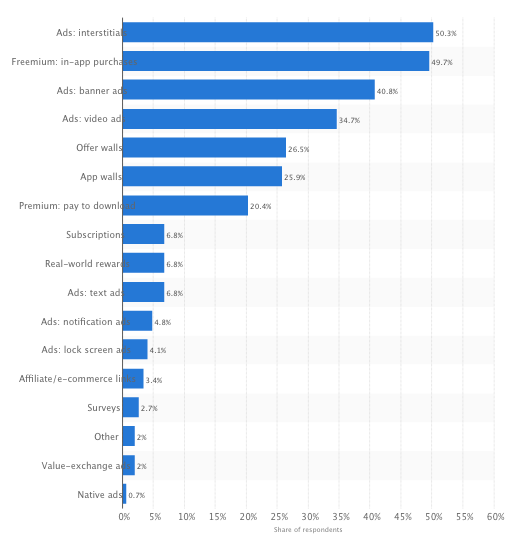- Paid apps
- In app advertising
- Freemium (using In app purchases for monetisation)
- Incentivised advertising
In app advertising (50.3% Interstitial and 40.8% Banner Ads) followed by Freemium model (49.7%) is the most preferred monetisation model used by app developers as can be seen in the following report:
- eCPM – effective revenue per thousands ad impressions
- Number of Ad Impressions shown to the user (N)
Based on the above, total revenue to the publishers can be calculated as:
Total Revenue = N X eCPM/1000
Further, Total Number of ad impression mainly depends on total number of sessions, which further depends on the number of active users (MAU or DAU). Thus, total number of ad impressions depend on some combination of following factors:
- Number of active users – For this MAU (Monthly Active User) or DAU (Daily Active User) can be used.
- Number of session per active user
- Average session duration
- Screen/Session
- Refresh rate of Banner Ads – Refresh rate determines frequency of ad impression being generated on a mobile app. Publishers can choose “No Refresh” option or refresh ads every 30 to 120 seconds. The default value of Refresh rate is “No Refresh” and the publisher can set this value to some value between 30 and 120 second. Google recommends to persist an ad for 60 second or longer.
- Number of interstitial ads per session
The calculation for total revenue changes based on the refresh rate set by the publisher and the frequency of ad request being made by the app. Generally app makes ad request to DFP only once for each screen view. But, app can increase the frequency of the ad request by making multiple ad request to DFP after some time interval.
We have divided this calculation for 2 scenario of refresh rate and the scenario when the app is making only 1 ad request to DFP for each screen view.
“No Refresh”
Refresh rate other than “No Refresh”
Further, we have made following assumption for our sample calculation:
|
Input Data
|
|
|
Active Users(MAU)
|
10000
|
|
Sessions per active Users
|
5
|
|
Screen/Session
|
6
|
|
Fill Rate
|
100%
|
|
Number of interstitial ads per session
|
1
|
|
eCPM-Banner (in $)
|
1
|
|
eCPM-Interstitial (in $)
|
4
|
We have used MAU as the measure of engagement, although DAU is also used for this purpose. Further, total number of sessions is the beginning point to calculate total revenue in either of scenario. At the same time, it is to be noted that Google analytics provides for total number of session and it does not provide for sessions per active users, although there is a linear relationship between active users and sessions per active users.
Scenario 1 (No Refresh Rate)
In case of refresh rate set as “No Refresh”, there is only one ad request made to DFP for each screen view. Consequently, there is only one ad in one screen view. In this scenario, the ad revenue can be calculated as follow:
|
Input Data
|
|
|
Active Users(MAU or DAU)
|
10000
|
|
Sessions per active Users
|
6
|
|
Total Number of Session
|
60000
|
|
Screen/Session
|
6
|
|
Total Number of Screen Views
|
360000
|
|
Total Number of Ad Request Made
|
360000
|
|
Fill Rate
|
100%
|
|
Total Number of Impressions
|
360000
|
|
Revenue Calculation
|
|
|
Number of interstitial ads per session
|
1
|
|
Number of Banner ads served
|
360000
|
|
Number of Interstitials ads served
|
60000
|
|
eCPM-Banner (in $)
|
1
|
|
eCPM-Interstitial (in $)
|
4
|
|
Earning from Banner ads (in $)
|
360
|
|
Earning from Interstitial ads (in $)
|
240
|
|
Total Earning (in $)
|
600
|
In this scenario, there is “No Refresh” option selected and app does not make more than 1 call for each screen view, total number of screen view rather than total time spent inside the app decides total revenue for the app. Thus, total number of screen views rather than total time spent inside the app has been used to calculate total revenue for the app.
Scenario 2 (Refresh Rate other than No Refresh)
In case of refresh rate other than “No Refresh” rate, there can be more than one ad shown to the users for each screen view. In this scenario, the ad revenue can be calculated as follow:
|
Input Data (Assumption)
|
|
|
Active Users(MAU or DAU)
|
10000
|
|
Sessions per active Users
|
6
|
|
Total Number of Session
|
60000
|
|
Average Session Duration (in Minutes)
|
2
|
|
Refresh Rate of ads (in Seconds)
|
30
|
|
Total Number of Ad Request Made
|
240000
|
|
Fill Rate
|
100%
|
|
Total Number of Impressions
|
240000
|
|
Revenue Calculation
|
|
|
Number of interstitial ads per session
|
1
|
|
Number of Banner ads served
|
240000
|
|
Number of Interstitials ads served
|
60000
|
|
eCPM-Banner (in $)
|
1
|
|
eCPM-Interstitial (in $)
|
4
|
|
Earning from Banner ads (in $)
|
240
|
|
Earning from Interstitial ads (in $)
|
240
|
|
Total Earning (in $)
|
480
|

